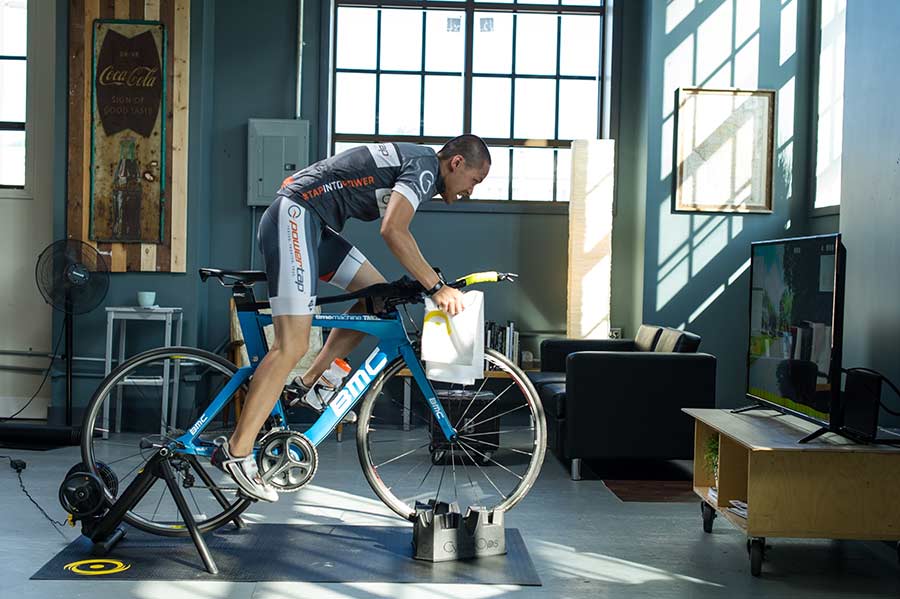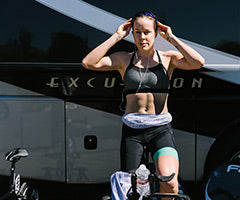By: Lindsay Goldman, professional cyclist for Hagens Berman | Supermint.
Despite having logged an insane number of hours riding indoors throughout my cycling career – probably around 1200 hours or FIFTY WHOLE DAYS – I still wouldn’t consider myself an expert on indoor training. It’s hard enough getting motivated to keep pedaling, so I outsource all the science and planning to my wonderful coach, Susan Hefler of Hefler Performance Coaching.
Susan has been my coach since 2014 and brought me from floundering roadie to confident professional cyclist through her wisdom, expertise, and knowledge of training and physiology. She has also gotten me through four cold, wet winters and one pregnancy, both of which required copious indoor riding and resulted in top-notch fitness. Susan is a big advocate of the merits of indoor training and kindly agreed to provide her guidance on incorporating the trainer into any athlete’s training plan.

Lindsay warming up before a race. (Photo credit: Snowy Mountain Photography)
1. What are the benefits of indoor training?
Hands down, the answer is quality training. Cycling indoors is a steady constant motion with no resting. Some of us are lucky enough to live where open roads exist, but many do not. Coming from Northern Virginia, I don't have anything longer than a 2-minute interval because of stoplights, intersections with stop signs, and so much traffic. With indoor training, one can ride anywhere from 1-3 hours and get tremendous steady riding benefits.
2. How much time should I take off my ride time if I'm riding indoors?
Indoor training is worth 50% more, so an hour inside is equivalent to 90 minutes outside. There is NO free pedaling, no coasting; you always have to apply pressure to pedal and generate wattage. The time savings are huge for those on tight schedules and/or facing a lack of daylight hours.

3. Weather permitting, how often should I do indoors versus outdoor training?
I would say the best answer to this is how much you can stand it. Balance is key in all sports and while indoor cycling is quality, there is little visual stimulation, connection with the outdoors, fresh air, etc. There are many reasons why people ride bikes, beyond just training for racing.
For some, cycling is purely a fitness tool and so these people may ride an hour a day, every day. That's fine. But for the riders spending 15+ hours a week on a bike, it is nice to balance indoor riding with "road legs" – getting outside and having awareness on the road/sharpening bike handling skills. You don't get any handling skills bolted to the floor on a trainer. So the short answer is that it depends on what your goals are and why you ride a bike.
4. How hard should I ride indoors?
Being that quality is the biggest reason for riding inside, many people do their harder workouts inside and endurance/easier rides outside. Endurance riding is not as difficult to control outside, whereas getting in perfectly timed intervals outside, in traffic, is almost impossible (unless you live in more remote places).
I would say the biggest advantage for indoor riding is the fact you can do perfect intervals at a prescribed intensity level and duration and never have to stop halfway through for a stoplight.

5. Why does it feel harder to ride inside than outside?
Mental stimulation. Outside, even when going hard, we can look around and see trees, birds, etc. Inside there is entertainment available (music, movies, etc.) but there is a lot more focus on “Here I am, inside on a bike.” For fitness rides lasting an hour per day, that may not be a big deal. But when you spend 2-3 hours on a bike trainer, it can be mentally taxing.
One important thing is to not abuse indoor riding; if it is going to be a solid 6 months of snow, balance trainer riding with cross-country skiing or strength and core work. Even the mentally super tough will get burned out if they do nothing but ride inside. There is not enough stimulation.
6. Why is my heartrate often higher when I ride inside?
This is likely due to heat and increased core temperatures; you want to have fans on you to keep your core temps down. Ideally, workout in a room where you can keep it cool and lower the thermostat. But even having a few fans on you will do the trick because once you start sweating, the fans work well to cool the body. It is crucial when indoor training to not overheat.
Some people think they should treat indoor riding like hot yoga session, but I wouldn't suggest this, especially if the workout calls for higher intensity. You will simply burn up. For those that have any form of cardio problems (and many are undiagnosed), it could be life or death. So use a fan to keep your core temps down and sweat a lot! It’s very cleansing and you won't burn up.

7. Any tips on maximizing the benefits of riding indoors?
- Figure out what works for you to pass the time: for some, rocking out on music works, for others, watching movies works. When you start to lose motivation, focus on the fact that the trainer is allowing you to get a high quality workout done in a short time period.
- Make sure you hydrate well, because without wind, you sweat more. Just like when training outside, use a hydration mix to replenish electrolytes. • Get out of the saddle periodically and move around. Change hand position on the bars.
- Use a high wheel block to simulate climbing and use different muscles.
- When you are riding for more than an hour and doing intensity, don't forget to take in calories.
- When you have had enough indoor training, go outside and look around. You have to have both – good quality training, but also time where your soul connects and gets fresh air. Balance is critical.

Lindsay Goldman is the Team Manager and racer for the Hagens Berman | Supermint women’s road cycling team. She has raced her bike professionally for the past five years across North America while also spending significant time riding the trainer to balance the demands of a busy work schedule and to combat rough winters.
She will be starting the 2018 race season by welcoming her first baby in February and then using her Hammer smart trainer to get back into shape to take on the later half of the pro road race calendar.
Follow her on Instagram and check out her blog at thedirtfield.com.
